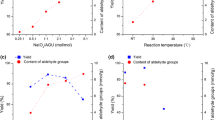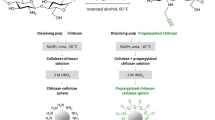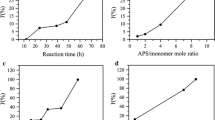Abstract
An efficient method for covalently linking of cellulose and clay using a click chemistry based strategy is reported. Azide and alkynyl derivatives of silane were synthesized and used for silanization of cellulose and clay respectively. Functionalized cellulose and clay were then coupled using Cu(I) catalyzed azide–alkyne cycloaddition reaction, resulting in a covalent linkage between them. Successful synthesis of the silane derivates was established using Fourier transform infrared (FTIR) and nuclear magnetic resonance. Silanization of cellulose and clay with azide and alkynyl derivatives and the formation of a triazole linkage were confirmed using FTIR.
Graphical Abstract











Similar content being viewed by others
Abbreviations
- APTES:
-
(3-aminopropyl)triethoxysilane
- DCC:
-
N,N’-dicyclohexylcarbodiimide
- DMAP:
-
4-dimethylaminopyridine
- DCM:
-
Dichloromethane
- DMSO:
-
Dimethylsulphoxide
- DMA:
-
Dimethylacetamide
- EtOAc:
-
Ethyl acetate
- EDC.HCl:
-
1-Ethyl-3-(3-dimethyllaminopropyl)carbodiimide hydrochloride
- PyBOP:
-
Benzotriazol-1-yl-oxytripyrrolidinophosphonium-hexafluorophosphat PyBOP
- HBTU:
-
O-Benzotriazole-N,N,N’,N’-tetramethyl-uronium-hexafluoro-phosphate
References
Abdelmouleh M, Boufi S, ben Salah A, Belgacem MN, Gandini A (2002) Interaction of silane coupling agents with cellulose. Langmuir 18(8):3203–3208
Abdelmouleh M, Boufi S, Belgacem MN, Dufresne A, Gandini A (2005) Modification of cellulose fibers with functionalized silanes: effect of the fiber treatment on the mechanical performances of cellulose–thermoset composites. J Appl Polym Sci 98:974–984
Abdul Khalil HPS, Bhat AH, Ireana Yusra AF (2012) Green composites from sustainable cellulose nanofibrils: a review. Carbohydr Polym 87(2):963–979
Binder WH, Sachsenhofer R (2007) ‘Click’ chemistry in polymer and materials science. Macromol Rapid Commun 28:15–54
Bledzki AK, Gassan J (1999) Composites reinforced with cellulose based fibres. Prog Polym Sci 24(2):221–274
Bovey FA, Winslow EH (1981) An introduction to polymer science. Academic press, New York
Chang C, Lue A, Zhang L (2008) Effects of crosslinking methods on structure and properties of cellulose/PVA hydrogels. Macromol Chem Phys 209(12):1266–1273
Coffey DG, Bell DA, Henderson A (2006) Food polysaccharides and their applications. Taylor and Francis, Boca Raton
Czaja WK, Young DJ, Kawecki M, Brown RM (2006) The future prospects of microbial cellulose in biomedical applications. Biomacromolecules 8(1):1–12
Dai JC, Huang JT (1999) Surface modification of clays and clay–rubber composite. Appl Clay Sci 15(1–2):51–65
Dam HH, Caruso F (2012) Modular click assembly of degradable capsules using polyrotaxanes. ACS Nano 6(6):4686–4693
Eichhorn S, Dufresne A, Aranguren M, Marcovich N, Capadona J, Rowan S, Weder C, Thielemans W, Roman M, Renneckar S, Gindl W, Veigel S, Keckes J, Yano H, Abe K, Nogi M, Nakagaito A, Mangalam A, Simonsen J, Benight A, Bismarck A, Berglund L, Peijs T (2010) Review: current international research into cellulose nanofibres and nanocomposites. J Mater Sci 45(1):1–33
Fournier D, Hoogenboom R, Schubert US (2007) Clicking polymers: a straightforward approach to novel macromolecular architectures. Chem Soc Rev 36(8):1369–1380
Freeman GM, Marshall CJJ, Lackey WO, Onizawa M (2000) Silane treated clay production method, silane treated clay and composition containing same. Sanyo Trading Co., J M Huber Corporation, Tokyo, Edison
Garcia de Rodriguez NL, Thielemans W, Dufresne A (2006) Sisal cellulose whiskers reinforced polyvinyl acetate nanocomposites. Cellulose 13(3):261–270
Himo F, Lovell T, Hilgraf R, Rostovtsev VV, Noodleman L, Sharpless KB, Fokin VV (2005) Copper(I)-catalyzed synthesis of azoles. DFT study predicts unprecedented reactivity and intermediates. J Am Chem Soc 127(1):210–216
Hoenich NA (2007) Cellulose for medical applications: past, present, and future. BioResources 1(2):270–280
Karaaslan MA, Gao G, Kadla JF (2013) Nanocrystalline cellulose/Î2-casein conjugated nanoparticles prepared by click chemistry. Cellulose 20(6):2655–2665
Krassig H, Steadman RG, Schliefer K, Albrecht W (1986) Ullmann’s Encyclopedia of organic compounds. VCH, New York
Liebert T, Hansch C, Heinze T (2006) Click chemistry with polysaccharides. Macromol Rapid Commun 27(3):208–213
Liu A, Walther A, Ikkala O, Belova L, Berglund LA (2012) Clay nanopaper with tough cellulose nanofiber matrix for fire retardancy and gas barrier functions. Biomacromolecules 12(3):633–641
Ludvik C, Glenn G, Klamczynski A, Wood D (2007) Cellulose fiber/bentonite clay/biodegradable thermoplastic composites. J Polym Environ 15(4):251–257
Ly B, Thielemans W, Dufresne A, Chaussy D, Belgacem MN (2008) Surface functionalization of cellulose fibres and their incorporation in renewable polymeric matrices. Compos Sci Technol 68(15–16):3193–3201
Manna AK, Tripathy DK, De PP, De SK, Chatterjee MK, Peiffer DG (1999) Bonding between epoxidized natural rubber and clay in presence of silane coupling agent. J Appl Polym Sci 72:1895–1903
Maren R, Shuping D, Anjali H, Yong Woo L (2009) Cellulose nanocrystals for drug delivery. Polysaccharide materials: performance by design, vol 1017. American Chemical Society, Washington, pp 81–91
Mohanty AK, Misra M, Hinrichsen G (2000) Biofibres, biodegradable polymers and biocomposites: an overview. Macromol Mater Eng 276–277(1):1–24
Mohanty AK, Misra M, Drzal LT (2002) Sustainable bio-composites from renewable resources: opportunities and challenges in the green materials world. J Polym Environ 10(1):19–26
Moses JE, Moorhouse AD (2007) The growing applications of click chemistry. Chem Soc Rev 36(8):1249–1262
Okiyama A, Motoki M, Yamanaka S (1992) Bacterial cellulose II. Processing of the gelatinous cellulose for food materials. Food Hydrocolloids 6(5):479–487
Orts WJ, Shey J, Imam SH, Glenn GM, Guttman ME, Revol J-F (2005) Application of cellulose microfibrils in polymer nanocomposites. J Polym Environ 13(4):301–306
Papalos JG (1966) Silane treated clay reinforced resin compositions. U. S. P. Office, J M. Huber Corporation, USA, Locust
Qin A, Lam JWY, Tang BZ (2010) Click polymerization: progresses, challenges, and opportunities. Macromolecules 43(21):8693–8702
Rostovtsev VV, Green LG, Fokin VV, Sharpless KB (2002) A stepwise huisgen cycloaddition process: copper(I)-catalyzed regioselective “ligation” of azides and terminal alkynes. Angew Chem Int Ed 41(14):2596–2599
Thirumurugan P, Matosiuk D, Jozwiak K (2013) Click Chemistry for drug development and diverse chemical-biology applications. Chem Rev 113(7):4905–4979
Thunwall M, Boldizar A, Rigdahl M, Banke K, Lindström T, Tufvesson H, Högman S (2008) Processing and properties of mineral-interfaced cellulose fibre composites. J Appl Polym Sci 107:918–929
Wan YZ, Huang Y, Yuan CD, Raman S, Zhu Y, Jiang HJ, He F, Gao C (2007) Biomimetic synthesis of hydroxyapatite/bacterial cellulose nanocomposites for biomedical applications. Mater Sci Eng C 27(4):855–864
Wheeler PA, Wang J, Mathias LJ (2006) Poly(methyl methacrylate)/laponite nanocomposites: exploring covalent and ionic clay modifications. Chem Mater 18(17):3937–3945
White LA (2004) Preparation and thermal analysis of cotton–clay nanocomposites. J Appl Polym Sci 92(4):2125–2131
Xie Y, Hill CAS, Xiao Z, Militz H, Mai C (2010) Silane coupling agents used for natural fiber/polymer composites: a review. Compos A Appl Sci Manuf 41(7):806–819
Yang MY, Li J, Chen PR (2014) Transition metal-mediated bioorthogonal protein chemistry in living cells. Chem Soc Rev 43(18):6511–6526
Zimmermann T, Pöhler E, Geiger T (2004) Cellulose fibrils for polymer reinforcement. Adv Eng Mater 6(9):754–761
Acknowledgments
The research was supported by Department of Science and Technology – Science and Engineering Research Board (DST-SERB), Grant number SERB/CESE/20120156. FTIR and NMR spectroscopy was done in the Chemistry department at IIT Kanpur. The authors are grateful to Prof. Amit Prashant of IIT Gandhinagar for generously donating kaolinite clay.
Conflict of interest
The authors declare no competing financial interest.
Funding Sources
This work is supported by DST-SERB (SR/S3/CE/038/2012).
Author information
Authors and Affiliations
Corresponding author
Electronic supplementary material
Below is the link to the electronic supplementary material.
Rights and permissions
About this article
Cite this article
Yadav, P., Chacko, S., Kumar, G. et al. Click chemistry route to covalently link cellulose and clay. Cellulose 22, 1615–1624 (2015). https://doi.org/10.1007/s10570-015-0594-2
Received:
Accepted:
Published:
Issue Date:
DOI: https://doi.org/10.1007/s10570-015-0594-2




